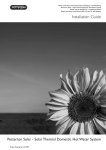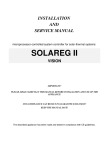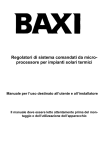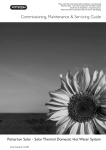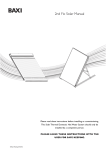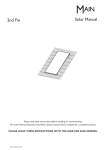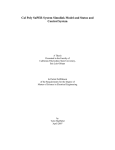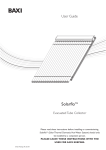Download Baxi Solarflo Installation guide
Transcript
Please read these instructions before installing or commissioning. The Solarflo - Solar Thermal Domestic Hot Water System should only be installed by a competent person. Please leave these instructions with the user for safe keeping. Installation Guide Solarflo - Solar Thermal Domestic Hot Water System © Baxi Heating UK Ltd 2007. Index 2 Index 3 Introduction to Solar 4 Solar collector specifications 5 Hydraulic station specifications 6 Differential temperature controller specifications 7 Ancillary components Expansion vessel Solar heat transfer fluid Thermostatic blending valve 8 Cylinder specifications Unvented Cistern-fed vented 10 General Safety information 12 Installation of collector panel sensor 13 Installation of hydraulic station Parts list Identification of components Pipework installation Positioning Installation of wall brackets Installing the safety group Connecting the solar expansion vessel Connecting pipework 19 Installation of solar controller Appliance installation Opening the controller Electrical connection overview General guidelines 230/240V~ connections Solar gain measurement Connection of temperature sensors Control of auxiliary heat input © BAXI Heating UK Ltd 2007. All rights reserved. No part of this publication may be reproduced or transmitted in any form or by any means, or stored in any retrieval system of any nature (including in any database), in each case whether electronic, mechanical, recording or otherwise, without prior written permission of the copyright owner, except for permitted fair dealing under Copyrights, Designs and Patents Act 1988. Applications for the copyright owner’s permission to reproduce or make other use of any part of this publication should be made, giving any details of the proposed use to the following address: The Company Secretary, BAXI Heating UK Ltd,The Wyvern Business Park, Stanier Way, Derby DE21 6BF. Full acknowledgement of author and source must be given. WARNING: Any person who does any unauthorised act in relation to a copyright work may be liable to criminal prosecution and civil claims for damages. 2 Solarflo - Solar Thermal Domestic Hot Water System Introduction to Solar Thank you for purchasing a high quality Baxi Solarflo Solar Thermal Domestic Hot Water System. The sun is the ultimate source of most of our renewable energy supplies. Energy from the sun is clean and abundant. There is a widely held opinion that the UK does not have enough sun to make solar systems worthwhile. In fact parts of the UK have annual solar radiation levels equal to 60% of those experienced at the equator. However, this energy is not received uniformly throughout the year. Some 70% of UK annual radiation is received over the period April to September and 25% is received in the months of June and July. Solar water heating technology captures energy from the sun and transfers this to a water heater to raise the water temperature therefore reducing the reliance on fossil fuel energies such as gas, oil and electricity. Up to 60% of a dwelling’s annual hot water requirement can be provided by a solar water heating system.The balance is provided by traditional means via a second heat exchanger connected to a fossil fuel boiler or electrical heating by electric boiler or immersion heater. Fig. 1 Solarflo - Solar Thermal Domestic Hot Water System The Baxi Solarflo water heating system provides all the principal components required for an efficient solar water heating system.The sun’s energy is captured by a series of solar collector panels through which a special heat transfer fluid is pumped. As the fluid passes through the collector panels its temperature is raised.The heated fluid is circulated through a heat exchanger coil in the base of the solar storage cylinder transferring the heat gained to the stored water, gradually raising its temperature. The cooled fluid then returns to the collector panel to be heated again. Heating by the solar coil is controlled by a solar differential temperature controller that ensures the system will only operate when there is useful solar heating gain at the collector panel. As the sun’s energy input to the collector panels is variable supplementary heating by a conventional boiler or electric immersion heater should be provided.The optional cylinders that can be supplied with the Baxi Solarflo package provide a supplementary heat exchanger coil and immersion heater as standard. 3 2.0 Fig. 2.1 Flow/return connections 83 1197 Temperature sensor pocket Ø8mm 117 70 1170 2.1 Solar collector specifications Technical data FK8200 “on roof” collector 2,02m2 1,84m2 39 kg 1,40 litres 10 bar 95% + _ 2% 5% + _ 2% 184°C (Max) Low-iron solar glass, tempered 3.2mm thick Light transmittance: >90.8% + _ 2% Insulation: 40mm Rockwool with black facing. Heat conductivity 0.045W/mK. Gross density 40-50kg/m3 Gross area: Net area: Weight: Absorber capacity: Pressure: Absorption: Emission: Stagnation temp: Glass: 1730 Pressure loss collector for anti-freeze/water mixture (40%/60%) at a thermal conducting temperature of 50°C. Pressure loss curve: Δp = 0,000206x2 + 0,007754x Mass flow rate [kg/h] 0 50 100 150 200 250 300 350 400 450 500 Pressure loss [mbar] 0 1 3 6 10 15 21 28 36 45 55 All dimensions shown in mm 2.2 1130 2,52m2 2,32m2 54 kg 1,70 litres 10 bar 95% + _ 2% 5% + _ 2% 210°C (Max) Low-iron solar glass, tempered 3.2mm thick Light transmittance: >90.8% + _ 2% Insulation: 50mm Rockwool with black fleece. Heat conductivity 0.045W/mK. Gross density 50-80kg/m3 Gross area: Net area: Weight: Absorber capacity: Pressure: Absorption: Emission: Stagnation temp: Glass: Temperature sensor pocket Ø8mm 1228 4 Solarflo - Solar Thermal Domestic Hot Water System Pressure loss collector for anti-freeze/water mixture (40%/60%) at a thermal conducting temperature of 50°C. Pressure loss curve: Δp = 0,0002x2 + 0,00301x 2104 2058 Fig. 2.2 Technical data IDMK in-roof collector 116 Mass flow rate [kg/h] 0 50 100 150 200 250 300 350 400 450 500 Pressure loss [mbar] 0 4 8 12 17 21 26 32 38 43 50 3.0 Hydraulic station specifications Fig. 3 3.1 Technical data Dimensions (Height/Width/Depth) Flow and return connections (compression fittings) Maximum working temperature: Maximum working pressure: Pressure Relief Valve setting: Circulating Pump: Circulating Pump voltage: Power consumption Setting 1: Setting 2: Setting 3: Maximum Pump Head: Maximum Pump Capacity: Flow meter scale: Solarflo - Solar Thermal Domestic Hot Water System 375/250/190mm 22mm 120°C 6 bar 6 bar Grundfos UPS 25-60 / Wilo ST 25/6 230/240 V ~ 45W / 45W 68W / 65W 90W / 85W 6 metres 4.5 m3/h / 3.5 m3/h 2 to 15 l/min 5 4.0 Differential temperature controller Fig. 4 4.1 Technical data Housing Material 100% recyclable ABS Dimensions L x W x D in mm weight 175 x 134 x 56 ca. 360 g Ingress protection IP40 according to VDE 0470 Electrical values Operating voltage 230/240V ~ 50 Hz Interference grade N according to VDE 0875 Max. conductor cross-section 240V-connections 2.5 mm2 fine-strand/single-wire Temperature sensor / temperature range PTF6 - 25°C to 200°C PT1000, 1,000 kΩ at 0°C Test voltage 4 kV 1 min according to VDE 0631 Switching voltage 230V / 240V Capability per one switch output 1A / ca. 230VA for cos j = 0,7-1,0 Total capability of all outputs 2A / ca. 460VA maximum Fuse protection fine-wire fuse 5 x 20mm, 2A/T (2 amperes, slow) Features Self explanatory, menu driven operation Adjustable control valves System monitoring Energy yield, (solar gain) measurement Suitable for flat plate and evacuated tube type collectors Reheat thermostat function Can be used in a number of system configurations 6 Solarflo - Solar Thermal Domestic Hot Water System 5.0 Ancillary components Fig. 5 5.1 Ø300mm Expansion vessel Expansion vessel Membrane expansion tanks for solar primary heating circuit. Manufactured according to the Directive PED 97/23/CE (approved noZ-DDK-MUC-02-396876-04). 3/4” 392mm Butyl membrane suitable for solar primary heating fluid, DIN 4807-3 approval. Maximum working temperature +110°C. Maximum percentage of glycol 50%. Connection: 3/4” BSP male parallel Pressure Loss kPa 22 mm Fig. 6.1 200 180 160 140 120 28 mm Expansion vessel supplied with wall mounting bracket and self sealing vessel connection that will allow removal of the vessel for maintenance without losing solar heat transfer fluid. 5.2 Solar heat transfer fluid Pre-mixed (40% glycol / 60% water) Solar thermal transfer fluid. Based on1,2 - propylene glycol with corrosion inhibitors. 100 Non-toxic, odourless, bio-degradable. 70 The use of chemical resistant gloves and suitable eye protection is required when handling. 50 40 A full safety data sheet is available on request. 30 0.2 0.3 0.4 0.5 Fig. 6.2 0.7 Flow l/s 1.0 1.4 2 Supplied in 20litre container.Weight of container full - 21kg. 5.3 92mm Thermostatic Blending Valve Can be set to control the hot water delivered to the user outlets to a safe working temperature enabling the solar cylinder to store water at a higher temperature. 81mm 22mm Hot Cold 60mm Mix 22mm Solarflo - Solar Thermal Domestic Hot Water System Connections: 22mm compression Max working pressure (static): 14 bar Max working pressure (dynamic): 5 bar Min working pressure (dynamic): 0.2 bar Max inlet pressure ratio: 2:1 Min flow required for stable control: 5 l/min For pressure drop diagram and dimensions see Fig. 6.1 & Fig. 6.2 NOTE: For optimum operation the cold connection must be taken from a balanced cold water feed. 7 6.0 Cylinder specifications Fig. 7 6.0 Unvented system - schematic diagram Unvented Nominal capacities 190, 210, 250 and 300 litre. Rating Immersion heater(s) 1 x 3 kW (indirect models), 2 x 3kW (direct models) @ 240V~. Outer casing White plastic coated corrosion proofed steel. Thermal insulation CFC/HCFC-free (ODP zero) flame-retardant expanded polyurethane (50mm thick). GWP 3.1 (Global Warming Potential). Water container Duplex 2304 (Grade 1.4362 EN 10088) stainless steel. Pressure testing To 15 bar. Heat unit Long-life Superloy 825 alloy sheathed element/s, incorporated into an easily removable heater plate, should replacement be necessary. Rated 3.0kW @ 240V~. Primary coil (for Auxiliary boiler heating) 22mm diameter stainless steel. Coil in coil design for improved performance Solar coil 25mm diameter stainless steel. Coil in coil design and large surface area for improved performance. Note: Indirect twin coil unit shown. Thermostat Direct models: Element thermostat adjustable from 10°C to 70°C. Indirect models: Factory-fitted cylinder thermostat adjustable to 70°C. Solar: Factory fitted control pocket suitable for insertion of solar controller temperature probe. Factory fitted safety features: Direct models: Manually re-settable cut-out on heating element operates at 85°C. Indirect models: High limit thermal cut-out operates at 85°C.Wired in series with two-port motorised valve (supplied) to provide primary over temperature protection when using auxiliary (boiler) coil. All models: Temperature and Pressure Relief Valve, factory set to operate at 10 bar and 90°C. High limit thermal cut-out operating at 85°C at solar coil position.Wired in series with the solar differential temperature controller to provide over temperature protection if overheating occurs from solar collector panels. N.B.This must be used in an unvented installation to comply with the requirements of Building Regulation G3. Anode Not required. For full technical and performance specification see cylinder installation instructions. The cylinders are unvented so installation must comply with Building Regulation G3. Baxi recommend the use of the Heatrae Sadia Megatech Unvented and Megalife vented cylinders. The use of other cylinders may not satisfy the requirements of Building Regulation G3. 8 Solarflo - Solar Thermal Domestic Hot Water System 6.0 Cylinder specifications Fig. 8 6.1 Vented system - schematic diagram Cistern-fed vented Nominal capacities 190, 210, 250 and 300 litre. Rating Immersion heater(s) 1 x 3 kW (indirect models), 2 x 3kW (direct models) @ 240V~. Outer casing White plastic coated corrosion proofed steel. Thermal insulation CFC/HCFC-free (ODP zero) flame-retardant expanded polyurethane (50mm thick). GWP 3.1 (Global Warming Potential). Water container Duplex 2304 (Grade 1.4362 EN 10088) stainless steel. 40 metres (4 bar) maximum working head. Heat unit Tin plated long-life Superloy 825 alloy sheathed element/s, incorporated into an easily removable heater plate, should replacement be necessary. Rated 3.0kW @ 240V~. Primary coil (for auxiliary boiler heating) 22mm diameter stainless steel. Coil in coil design for improved performance. Solar coil 25mm diameter stainless steel. Coil in coil design and large surface area for improved performance. Thermostat Direct models: Element thermostat adjustable from 10°C to 70°C. Note: Direct unit shown. Auxiliary heating by immersion heater. Indirect models: Factory-fitted cylinder thermostat from 10°C to 70°C. Solar: Factory fitted control pocket suitable for insertion of solar controller temperature probe. Safety features Thermostats with manually resettable thermal cut-out. High limit thermal cut-out operating at 85°C at solar coil position.Wired in series with the solar differential temperature controller to provide over temperature protection if overheating occurs from solar collector panels. Anode Not required. For full technical and performance specification see cylinder installation instructions. Detailed installation and commissioning instructions are supplied with the cylinders. Note: The Baxi Solarflo is also compatible with cylinders configured for solar DHW systems. For installation and specification details refer to the manufacturers instructions supplied with the solar cylinder. Solarflo - Solar Thermal Domestic Hot Water System 9 7.0 7.1 General Safety information In order to reduce the number of deaths and major accidents attributable to work at height, the Health and Safety Executive has introduced comprehensive regulations and guidance that should be followed by all businesses working at height. We consider in the following paragraphs some of the main features of the regulations and guidance.This is, however, only a limited summary and it is recommended that all businesses planning on undertaking solar water heating installations obtain a copy of the regulations and guidance issued by the Health and Safety Executive and carefully consider the contents. The regulations and guidance state that you are required to carry out a risk assessment for all work conducted at height and to put in place arrangements for: • Eliminating or minimising risks from work at height. • Safe systems of work for organising and performing work at height. • Safe systems for selecting suitable work equipment. • Safe systems for protecting people from the consequences of work at height. The regulations and guidance highlight a hierarchy for safe work at height: • Avoid the risk by not working at height if practicable. • Prevent falls, where it is not reasonably practicable to avoid work at height; you are required to take suitable and sufficient steps to prevent the risk of a fall including selecting the most suitable work equipment (in accordance with the regulations). • Mitigate the consequences of a fall; where the risk of a person or object falling still remains, take suitable and sufficient measures to minimise the distance and consequences of any fall. Collective protection measures, such as guard rails on scaffold, should be given priority over personal protection measures, such as safety harnesses. Within the regulations’ framework, you are required to: 1) Assess the risk to help you decide how to work safely. 2) Follow the hierarchy for safe work at height (i.e. avoid, prevent and mitigate). 3) Plan and organise your work properly, taking account of weather conditions and the possibility of emergencies. 4) Make sure those working at height are competent. 5) Make use of appropriate work equipment. 6) Manage the risks from working on or around fragile surfaces and from falling objects. 7) Inspect and maintain the work equipment to be used and inspect the place where the work will be carried out (including access and egress). When preparing to install a solar water heating system, it is required that you perform a risk assessment in relation to work at height and plan how you will organise your work, taking into account the site, the weather conditions and the experience and competence of colleagues or contractors who may be working at height with you. 10 Solarflo - Solar Thermal Domestic Hot Water System 7.0 General Risk Assessments The HSE has published a number of very useful free publications that advise how to undertake risk assessments. Two of these that you should obtain are: Five Steps to Risk Assessment. A Guide to Risk Assessment Requirements. The five steps outlined in the HSE leaflet are: Step 1: Look for the hazards This will mean looking at the site and identifying significant hazards.These could be features such as a steep roof, a fragile surface where the collectors may be mounted, uneven ground or obstructions where access to the roof might be required. Step 2: Decide who may be harmed and how This might mean considering the particular risks that young workers or trainees might face and thinking about the residents of the household or visitors who could be hurt by your activities. Step 3: Evaluate the risks and decide which precautions should be made You should consider how likely it is that each hazard will cause harm, decide which precautions you might take and then assess, after you have taken those precautions, whether the remaining risk will be high, medium or low.Where you identify remaining risks, you should consider which further action you could take to control the risks so that harm is unlikely. Step 4: Record your findings If you have fewer than five employees you do not need to write anything down, though it is useful to keep a written record of what you have done. If you employ five or more people you must record the significant findings of your assessment.You must also tell your employees about your findings.You need to be able to show that a proper check was made, that you considered who might be affected, that you dealt with all the obvious significant hazards, that the precautions you propose are reasonable and that the remaining risk is low. Step 5: Review your assessment if necessary Each solar water heating installation may bring its own challenges and present its own particular hazards.You should therefore be careful not to rely on a “standard” risk assessment for installing a solar water heating system in a house, but review the particular hazards for each new situation.The issue of work equipment must be considered, but at the preparation stage you should consider where scaffold or other access equipment might be positioned and look out for any obvious obstacles to this, such as a conservatory or porch. In addition to the risks associated with work at height, you should also consider the risks associated with lifting and carrying solar collectors, using electric drills and using blow lamps or blow torches for soldering.This is not an exclusive list and so you should consider all aspects of the proposed installation to assess whether there are additional risks that need to be taken into account. Solarflo - Solar Thermal Domestic Hot Water System 11 8.0 Installation of collector panel sensor Fig. 9 The Collector panel temperature sensor should be installed in the sensor pocket nearest to the collector array flow. It should be secured in pocket by inserting through the rubber gland provided. All materials used for installing temperature sensors (sensor element, conducting compound, cables, sealing and insulating materials) must be suitably temperature resistant (up to 250°C). NOTE: “On-roof” type panel shown.The “In-roof” type panel has connections on the top edge of the collector (see Fig. 2.2) and the sensor pocket is located behind the left hand connection. 12 Solarflo - Solar Thermal Domestic Hot Water System 9.0 Installation of hydraulic station Fig. 10 (Diagrams not to scale) 9.1 Before commencing the installation check all listed components are contained in the following cartons. 3 1 Parts list Hydraulic Station carton: 1. Hydraulic pump station with insulation incorporating wall mounting bracket. 2. Solar differential temperature controller. 2 4 3. Safety group, comprisingPressure relief valve, pressure gauge and fill & drain valve. 4. 22mm compression fitting (4 off). 5 5. Re Heat sensor. 6. Solar Gain Module comprisingElectric flowmeter and return temperature sensor. 7. Sensor extension cable (13m) (not shown). 6 Ancillary component carton: 8 Solar expansion vessel complete with mounting bracket and strap assembly. 9. Expansion vessel connecting hose. 10. Expansion vessel self sealing connection. 11. Thermostatic Blending valve. 8 12. 2m insulated flexible steel hoses for connection to collectors 9 12 11 10 Solarflo - Solar Thermal Domestic Hot Water System 13 9.0 Installation of hydraulic station Fig. 11 9.2 Identification of components The main components of the hydraulic station are: 1 – Two isolating valves (Fig. 11, Item 1 & 2) with integral thermometers which display the solar primary flow and return temperatures. – A safety group (Fig. 11, Item 3, supplied unconnected), which protects the solar primary circuit.The pressure relief valve and pressure gauge are integrated in the safety group. – A non-return valve in both feed and return prevents the possibility of gravity circulation in the solar primary circuit. – A solar circulation pump (Fig. 11, Item 4). – A flow meter with fill & drain valve and shut-off valve (Fig. 11, Item 5). – An air separator. 3 2 4 6 5 The heat transfer fluid is circulated by the solar circulation pump integrated in the hydraulic pump station (Fig. 11). The hydraulic station has a solar differential temperature controller (Fig. 11 Item 6) integrated into the front insulation moulding.This is pre-wired to the solar pump. 14 Solarflo - Solar Thermal Domestic Hot Water System 9.0 Installation of hydraulic station Fig. 12 9.3 See Fig. 12 5 1 2 3 4 5 6 7 8 9 4 3 Solar cylinder Collector temperature sensor lead Solar primary flow (from collector) Solar collector panel(s) Solar primary return (to collector) Solar primary flow (to cylinder) Solar primary return (from cylinder) Solar differential temperature controller Cylinder temperature sensor lead 1 2 9.4 8 7 9 Pipework installation - general The collectors, the hydraulic station and the solar cylinder (Fig. 12, Item 1) must be connected with hard soldered copper pipes, compression fittings or baxi multifit accessory flexible steel tube and insulation 5122238. N.B. Plastic pipes MUST NOT be used. 6 Connections supplied are suitable for pipe diameters of 22mm. However for short pipe runs (up to 10m) the use of 15mm diameter pipe is acceptable. In solar heating systems, use only pipes and fittings made from copper, brass, bronze brass or stainless steel. Compression fittings only must be used. All connections and joints must be resistant to temperatures of up to 150°C and resistant to glycol. The height difference between the highest point in the pipework (collector) and the hydraulic station may be a maximum of 15m (this is called the ‘static height’). If the static height is greater than 15m a larger expansion vessel may be required. If any pipe sealants are used these should be resistant to glycol and be able to withstand temperatures of up to 150°C. 9.4.1 Earthing pipework All solar primary pipework between the solar collectors, hydraulic station and solar cylinder must be earth bonded to avoid electrical potential differences.This work must be carried out by a qualified electrician. Fit earthing clamps to the solar primary flow and return pipes and connect the earth clamps to the earthing system of the property using an earth bonding cable of min. 6mm2 diameter. Solarflo - Solar Thermal Domestic Hot Water System 15 9.0 Installation of hydraulic station 9.4.2 Venting the pipework Fig. 13 The Baxi Solarflo hydraulic station the component includes an air collector/separator and bleed point so an automatic air vent is not necessary. Any section of solar pipework that falls and rises again should be fitted with an additional air vent valve to relieve any trapped air which may cause air locking in the system.The automatic air vent and isolating valve used must be compatible with solar primary systems, i.e. be resistant to glycol and temperatures up to 180ºC. 9.4.3 Insulating the pipework External pipework should be insulated with high temperature resistant materials and be protected against UV degradation. Internal pipework, especially through unheated spaces such as a loft space, should also be insulated with high temperature resistant materials. Mark the outside of any insulation to identify the flow and return pipes. The Baxi Solarflo panels are supplied with 2x2m pre insulated flexible stainless steel tubes. Additional lengths (30m) of stainless steel flexible tubes and high temperature insulation can be supplied. 16 Solarflo - Solar Thermal Domestic Hot Water System 9.0 Installation of hydraulic station Fig. 14 9.5 Installing the hydraulic station - positioning It is usual to install the hydraulic station and solar differential temperature controller near to the solar cylinder. However this does not have to be the case, the hydraulic station can be installed anywhere convenient on the solar primary pipework although adequate access will be necessary for commissioning and maintenance. The solar differential controller should also be accessible for system operational monitoring. If not in close proximity to the solar cylinder it will be necessary to extend the solar cylinder temperature sensor cable, refer to section 10.6 for details of how to do this. It is recommended that the upper mounting bracket of the hydraulic station is positioned approx. 1600 to 1700mm above the floor level for ease of access and operation of the controls, see Fig. 14. When choosing the site for the hydraulic station provision of a discharge pipe from the safety group and the location of the solar expansion vessel must be considered. 9.6 Fig. 15 1 2 4 6 Installing the wall brackets and hydraulic station Remove the front insulation moulding (Fig 15. Item 1) by pulling forward whilst holding the solar differential controller moulding (Fig 15. Item 2) in place. carefully remove the solar differential controller mounting by pulling forward and disconnect the pump cable connector (Fig 15. Item 3). Place the hydraulic assembly on the wall at the desired location and mark the fixing positions through the holes in the mounting brackets. Remove the hydraulic assembly from the mounting brackets (Fig 15. Item 4) and remove rear insulation moulding (Fig 15. Item 5). Drill and plug the mounting positions and screw the mounting brackets into position. Push the rear insulation moulding over the wall brackets and refit the hydraulic assembly (Fig 15. Item 6) to the mounting clips on the wall brackets. 5 4 3 Solarflo - Solar Thermal Domestic Hot Water System 17 Fig. 16 1 3 9.0 9.7 Installation of hydraulic station Installing the safety group 2 Connect the safety group (Fig 16 Item 1) with the gasket (Fig 16 Item 2) enclosed to the connection on the hydraulic station return isolating valve assembly (Fig 16 Item 3). Fig. 17 9.8 Connecting the solar expansion vessel 4 5 3 1 2 Fig. 18 DO NOT replace the solar expansion vessel with either a potable water expansion vessel or boiler sealed system vessel. Return to panel Flow from panel Mount the solar expansion vessel (Fig 17 Item 1) adjacent to the hydraulic station (Fig 17 Item 2) so that the vessel can be connected to the vessel connection of the safety group (Fig 17 Item 3) using the flexible pipe (Fig 17 Item 4) supplied. (Note: Solar expansion vessel, mounting bracket, self sealing connection and flexible pipe are supplied in the Ancillary Components kit).The vessel must be mounted as shown (connection to top) and securely supported using the wall bracket supplied.The self sealing vessel connection should be screwed onto the vessel connection before connecting the flexible pipe (Fig. 17 Item 5). 3 The charge pressure at the solar expansion vessel should be adjusted such that when not under load the charge pressure is 0.4 bar above the static system head (the height of the top of the collector panels above the hydraulic station). A one metre head represents 0.1 bar. However, the charge pressure should be at least 1.2 bar. The maximum static system head is 15m (1.5 bar). 2 9.9 Connecting pipework 1 Flow to cylinder Connect the flow and return pipes to the collectors and to the cylinder via compression fittings (Fig 18 Item 1). Fittings are for 22mm o/dia pipe. Support the hydraulic assembly when tightening connections. Return from cylinder 4 Fig. 19 18 Run a pipe (Fig 18 Item 2) from the exit opening in the pressure relief valve (Fig 18 Item 3) to a suitable container (Fig 18 Item 4) and secure it. Return to hydraulic station Return from cylinder 9.9.1 Installing a drain valve Install a device for draining the solar heating system (tee piece with drain valve, Fig. 19) into the flow and return at the lowest point in the solar heating system. Flow to cylinder 9.9.2 Connecting the solar cylinder For detailed installation instructions refer to the installation instructions supplied with the solar cylinder. Solarflo - Solar Thermal Domestic Hot Water System 10.0 Installation of solar controller Fig. 20 Hydraulic Station Solar panel sensor Solar differential controller 10.1 Appliance installation The solar differential temperature controller is designed to be mounted on the front of the hydraulic station. Alternatively it can be removed from the insulation and be wall mounted (see panel below). In the case of wall mounting the pump cable may need to be lengthened. Alternative mounting option Terminal block for extending collector sensor Double pole isolating switch L N E 230V/240V~ Mains supply Pump pre-wired (mounted on hydraulic station) Cylinder sensor In the case of wall installation proceed in the following way: Drill installation holes according to the dimensions shown below. Screw in two upper screws up to 6 mm distance. Open the appliance as described in section 10.2 and hang it onto two screws. Now two lower screws can be mounted.Tighten all screws. Do not overtighten to avoid damage to the controller backplate. 126mm 84mm 118mm 10.2 Opening the controller No tools are required to open the controller.The front of the controller is secured by two latches which engage with the controller backplate. It can be opened by gently pulling the lower side edges outwards and then hinging the front upwards. 10.3 Electrical connection overview Always disconnect from the mains before opening the controller cover. The electrical installation must conform to all current Wiring Regulations and be carried out by a competent electrician. The connection of all electrical cables is to the terminal block located on the backplate of the controller.The terminals on the right side of the terminal block are for extra low voltage connections (temperature sensors and flow transmitters).The terminals on the left side of the terminal block are for 230/240 V~ connections. Solarflo - Solar Thermal Domestic Hot Water System 19 10.0 General connection guidelines. Fig. 21 WMM PE T1 T2 L N A1 N A2 N A3 N T3 T4 T6 low voltage area Earthed wire Mains supply live conductor Mains supply neutral conductor Switch output to solar pump Neutral wire to solar pump Live switch output 2 Neutral wire switch output 2 Live switch output 3 Neutral wire switch output 3 WMM T1 T2 T3 T4 T5 T6 For switch functions A2 and A3 see Fig. 23 Flow transmitter Temp.- sensor collector 1 Temp.- storage tank 1 Temp.- sensor collector 2/ storage tank 2 Temp.- sensor collector return Temp.- sensor thermostat or for 2nd temperature differential controller Temp.- sensor antifreeze or for 2nd temperature differential controller Cables are inserted in the controller through knockouts provided in the controller backplate. Flexible cables must be secured against straining by suitable strain relief bushes or devices. The controller must be earthed. 10.4 230/240V~ connections For 230V connections you must follow the following points: The mains supply to the controller should be via a suitable double pole isolating switch with a contact separation of at least 3mm in both poles. Additionally for unvented solar cylinders the controller should be wired via the solar coil over temperature cutout such that power is interrupted to the controller and hydraulic station in the event of the unvented cylinder overheating (see Fig. 22). Controllers are intended for the operation in 230/240V~ /50Hz mains. Any motorised valves connected must be suitable for this voltage. All earth wires must be connected to terminals marked with PE. Any bare wire earth conductors must be sleeved with green/yellow sleeving. The neutral terminals (N) are electrically connected and are not switched. Fig. 22 Hydraulic Station Solar differential controller Double pole isolating switch Solar coil over-temp cut-out L N E 230V/240V~ Mains supply 20 In the case of all connecting wires the outer sheath should be stripped back to 80mm.The individual conductor sleeving should be stripped approx. 10mm. T5 mains voltage area PE L N A1 N A2 N A3 N Installation of solar controller Solarflo - Solar Thermal Domestic Hot Water System All switch outputs (A1, A2 and A3) are 230/240V~ closers. If potential-free contacts are needed, appropriate accessories are required. Fig. 23 Type 0: 1 collector, 1 storage tank 10.0 Tcoll 10.5 Collector Storage tank Solar Gain measurement For solar gain (energy productivity) measurement it is necessary to fit the flowmeter and collector return sensor as shown in the diagram in Fig. 23.The collector return sensor must be securely attached to the return pipework using the securing tiles supplied and then covered by insulation.The solar gain of the system is calculated on the basis of the temperature difference between the collector flow and return and the solar primary circulation flow rate. The function must be switched “on” when commissioning the Solar Differential Temperature Controller. Refer to the Baxi Solarflo “Commissioning, Maintenance & Servicing Guide” for further details. Tth P Tst FM Tret Type 2: 1 collector, 2 storage tanks with 2 pumps Tcoll Storage tank1 Installation of solar controller For System Types 2 and 4 the additional pump (P2) can be ordered as an accessory, Part No. 5129362. Storage tank2 Tth Collector Tst1 Tst2 FM P1 Tret P2 Type 4: 2 collectors, 1 storage tank with 2 pumps Collector 1 Tcoll1 Tcoll2 Tcoll Tth Tret Tst P FM Storage tank1 Tth P1 Tst P2 Temperature Temperature Temperature Temperature Pump Flowmeter measuring measuring measuring measuring point point point point collector thermostat collector return storage tank FM Tret System type Output terminal designation (see Fig. 21) Type Description A1 A2 A3 0 1 collector array, 1 storage cylinder P1 - Cooling or thermostat or diff. controller 2 1 collector array, 2 storage cylinder (pump-pump) P1 P2 Cooling or thermostat or diff. controller 4 2 collector array, 1 storage cylinder (pump-pump) P1 P2 Cooling or thermostat or diff. controller System type Sensor terminal designation (see Fig. 21) Type Description T1 T2 T3 T4 T5 T6 0 1 collector array, 1 storage cylinder Tcoll1 Tst1 - Tret Tth/TDiff1 Tfr TDiff2 2 1 collector array, 2 storage cylinder (pump-pump) Tcoll1 Tst1 Tst2 Tret Tth/TDiff1 Tfr TDiff2 4 2 collector array, 1 storage cylinder (pump-pump) Tcoll1 Tst1 Tcoll2 Tret Tth/TDiff1 Tfr TDiff2 NOTE:The solar gain flowmeter must be connected to sensor terminals marked WMM (see Fig. 21). Solarflo - Solar Thermal Domestic Hot Water System 21 Fig. 24 10.0 Block Wiring Schemes A. Solarflo in conjunction with auxiliary heating by boiler - no reheat control by solar controller. 3A Fused Supply L N Boiler Terminal Strip E 1 2 3 1 2 3 7 10 1 2 3 L PL N 1 4 2 3 5 6 7 8 9 10 3 3 2 10 1 5 E G/Y BL BR GR OR 1 L N E 1 2 3 2 3 2 2 N G/Y BL 9 1 5 4 BR GR OR L CH 2 Port Valve Room Stat 3 2 2 11 12 PE L N A1 N 3 1 2 E Installation / cabling of temperature sensors: Mount the sensors in the pockets provided in the collector and storage tank. When installing into the collector panel sensor pocket the sensor should be secured by inserting through the rubber gland provided. A1 See Fig. 20 T1 T2 2 3 N E The wires of the temperature sensors can be lengthened. Up to 15m long you need a 2 x 0,5mm2 cross-section, up to 50m 2 x 0,75mm2. In the case of long connections (collector) shielded extension lead must be used. DO NOT run sensor leads adjacent to mains carrying voltage conductors (at least 50mm separation is recommended). CH Pump T4 WMM 11 N PE 12 E Solar Pump Solar Differential Controller Solar Controller L 6 Terminal Box (Not supplied) DHW 2 Port Valve 9 1 DHW ON CH ON 7 Connection of temperature sensors The controller uses precise platinum temperature sensors type PT1000.The controller is supplied with 3 sensors. The sensor with black silicone sheathing must be used for the solar panel sensor. Programmer SL 5 4 Cylinder Auxiliary Controls 6 E 10.6 Installation of solar controller Note: For Boilers without Pump over run CH Pump Live Supply to 5 Temperature sensors are connected according to the appropriate terminals, refer to Fig 21. The sensors are polarity free. B. Solarflo in conjunction with auxiliary heating by boiler - reheat control via solar controller. Sensors MUST NOT be connected to the 230/240V~ terminals. Solar O/Temp Cutout 3A Fused Supply Boiler Terminal Strip Programmable Room Stat L N E L PL N E SL L N 1 2 1 2 3 1 4 2 3 5 1 2 1 6 1 2 3 5 7 10 1 2 3 4 6 7 8 9 10 3 3 2 10 1 5 E G/Y BL BR GR OR 10.7 When using the reheat function the operation of the auxiliary heat input device can be controlled via output A3 from the controller. Terminal Box (Not supplied) DHW 2 Port Valve Cylinder Auxiliary Controls 3 2 G/Y BL 6 1 5 4 BR GR OR L CH 2 Port Valve 3 8 2 11 12 7 2 PE L N A1 N A3 N 1 8 3 1 2 E 2 3 N E The reheat sensor cable should be connected to terminals T5 of the solar controller and the sensor element be inserted into the controls pocket at the auxiliary heater level. CH Pump See Fig. 20 T1 T2 T4 T5 WMM A1 N PE 11 12 E Solar Pump Solar Differential Controller C. Solar Cylinder with auxiliary heating by immersion heater. Boiler Immersion 3 Amp Fused Supply 13 Amp Fused Supply L N E 1 2 3 1 2 3 4 3 8 2 11 12 PE L N A1 N L N E 4 5 6 5 6 7 8 9 Relay A3 10 Terminal Box (Not supplied) A1 See Fig. 20 N T1 T2 T4 T5 WMM Solar Differential Controller 8 3 1 2 E Solar O/Temp Cutout 22 N.B.The maximum switching current of the controller is 2A so if switching an electrical immersion heater this MUST be done via a relay (see Fig. 24 Black Wiring Scheme C) order accessory code No. 5122765. If using a boiler for auxiliary input, the output from the reheat function should be integrated into the boiler control circuit. Solar O/Temp Cutout 1 Control of Auxiliary heat input PE 12 E Solar Pump A3 N 4 7 7 5 6 1 5 CoM No L N E Auxiliary Immersion Heater Relay 11 N Immersion Heater Solarflo - Solar Thermal Domestic Hot Water System 10.0 Installation of solar controller D. Auxiliary heating by boiler with 3 port mid position valve system - no reheat control by solar controller. 3A Fused Supply L N E L 1 2 3 1 2 3 4 8 5 7 1 2 3 PL N 1 4 2 3 5 7 8 9 3 3 2 10 NOT USED E G/Y BL BR GR 10 L N E 1 2 3 3 2 N G/Y 2 11 12 N A1 N 3 1 2 E 7 6 OR 2 9 7 5 4 BL WH GR OR L A1 See Fig. 20 T1 T2 T4 2 3 N E CH Pump WMM 11 N PE 12 E - reheat control by solar controller. 3A Fused Supply Boiler Terminal Strip E L 1 2 3 1 2 3 4 8 5 7 1 2 3 PL N E SL 1 4 2 3 5 6 7 8 9 3 3 2 5 NOT USED E G/Y BL BR GR 10 L N 1 2 1 2 1 9 G/Y OR 2 9 7 5 4 BL WH GR OR L 3 Port Mid Position Valve 3 6 2 11 12 8 2 PE L N A1 N A3 N T2 1 2 E 3 N E A1 See Fig. 20 T1 2 CH Pump T4 T5 Solar Differential Controller 3 The Warranty only applies to equipment and controls supplied with the Solarflo System. Terminal Box (Not supplied) DHW 2 Port Valve 3 6 The various ancillary equipment manufacturers should be consulted to confirm the correct operation of their products within the system. Programmable Room Stat 5 Cylinder Auxiliary Controls 1 Live Neutral Earth Pump Live Switched Live Green and Yellow Blue Brown Grey Orange White Baxi accept no liability for any loss or damage arising from any errors or omissions that may be inadvertently contained within these diagrams. E. Auxiliary heating by boiler with 3 port mid position valve system N - These diagrams are presented for guidance only, terminal numbers may differ between different manufacturers equipment. Solar O/Temp Cutout L L N E PL SL G/Y BL BR GR OR WH The wiring schemes assume the use of an unvented Solar DHW cylinders. Solar Pump Solar Differential Controller 1 8 Terminal Box (Not supplied) 3 Port Mid Position Valve Solar Controller L DHW ON DHW OFF CH ON 2 Port Valve 2 L SL 6 Room Stat PE E 1 9 3 Programmer 5 Cylinder Auxiliary Controls 6 Key to abbreviations: Boiler Terminal Strip WMM 11 N PE 12 E Solar Pump Solar O/Temp Cutout Solarflo - Solar Thermal Domestic Hot Water System 23 All descriptions and illustrations provided in this leaflet have been carefully prepared but we reserve the right to make changes and improvements in our products which may affect the accuracy of the information contained in this leaflet. All goods are sold subject to our standard Conditions of Sale which are available on request. B AXI A Trading Division of Baxi Heating UK Ltd, a division of Baxi Group. Brooks House, Coventry Road,Warwick. CV34 4LL After Sales Service and Technical Enquiries 08700 603261 Our contact centre is open Monday to Friday 8am to 6pm, Weekends and Bank Holidays 8.30am to 2pm. We are closed Christmas Day and New Years Day. Website www.baxi.co.uk © Baxi Heating UK Ltd 2007. Comp No 3600 5979 - Issue 1 - 5/07
























